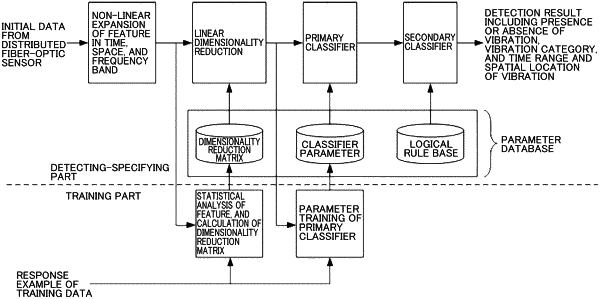| CPC G01H 9/004 (2013.01) [G06F 18/214 (2023.01); G06F 18/2135 (2023.01); G06F 18/22 (2023.01); G06F 18/24137 (2023.01); G06F 18/24323 (2023.01); G06N 5/01 (2023.01); G06N 20/10 (2019.01)] | 7 Claims |

|
1. A method for detecting and specifying a vibration on the basis of a feature of a fiber-optic signal to determine a time and a spatial location, comprising:
Step 1 of acquiring a feature-expanded function vector and C-number of vibration categories by expanding a feature of initial data of a vibration signal from a distributed fiber-optic sensor;
Step 2 of calculating a dimensionality reduction matrix based on the feature-expanded function vector;
Step 3 of acquiring a dimensionality-reduced feature function by operating the dimensionality reduction matrix to the initial data and the feature-expanded function vector;
Step 4 of acquiring a primary classification result of the vibration signal by performing a classification with reference to a primary classification parameter acquired from a parameter database; and
Step 5 of acquiring and outputting a secondary classification result of the vibration signal by performing removal of a wrong detection result and correction of a wrong classification result of the primary classification result, wherein
Step 2 includes:
Sub-step 21 of collecting a training sample set represented by the following Equation 1 for vibration category c;
Sub-step 22 of calculating, for each vibration category, a center of a cluster represented by the following Equation 2, a variance within the cluster represented by the following Equation 3, a sum of variances within clusters represented by the following Equation 4, a center of all the data represented by the following Equation 5, and a variance between clusters represented by the following Equation 6; and
Sub-step 23 of calculating a feature value of a matrix represented by the following Equation 7, decomposing the matrix, acquiring Q-number of maximum feature values and corresponding feature vectors, and composing the dimensionality reduction matrix by using columns of the feature vectors,
 where, in Equation 1, gk(c) denotes a k-th training sample in vibration category c,
 where, in Equation 2, Kc denotes the number of training samples in the category c,
 where, in Equation 4, C denotes the total number of vibration categories,
 |